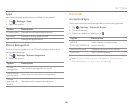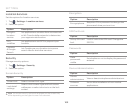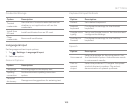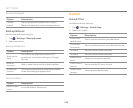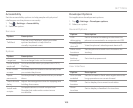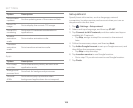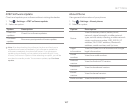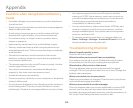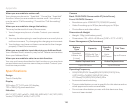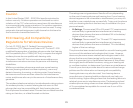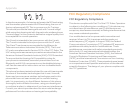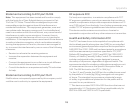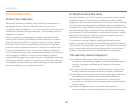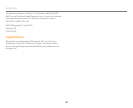
112
Appendix
In the above example, if a hearing aid meets the M2 level rating
and the wireless phone meets the M3 level rating, the sum of
the two values equals M5. This is synonymous for T ratings.
This should provide the hearing aid user with “normal usage”
while using their hearing aid with the particular wireless phone.
“Normal usage” in this context is defined as a signal quality that
is acceptable for normal operation.
The M mark is intended to be synonymous with the U mark.
The T mark is intended to be synonymous with the UT mark.
The M and T marks are recommended by the Alliance for
Telecommunications Industries Solutions (ATIS). The U and
UT marks are referenced in Section 20.19 of the FCC Rules. The
HAC rating and measurement procedure are described in the
American National Standards Institute (ANSI) C63.19 standard.
To ensure that the Hearing Aid Compatibility rating for
your phone is maintained, secondary transmitters such as
Bluetooth and WLAN components must be disabled during a
call. See the manual for instructions on how to disable these
components.
This phone has been tested and rated for use with hearing aids
for some of the wireless technologies that it uses. However,
there may be some newer wireless technologies used in this
phone that have not been tested yet for use with hearing
aids. It is important to try the different features of this phone
thoroughly and in different locations, using your hearing aid
or cochlear implant, to determine if you hear any interference.
Consult your service provider about its return and exchange
policies and for information on hearing aid compatibility.
FCC Regulatory Compliance
FCC Regulatory Compliance
This device complies with Part 15 of the FCC Rules. Operation
is subject to the following two conditions: (1) this device may
not cause harmful interference, and (2) this device must
accept any interference received, including interference that
may cause undesired operation.
Your mobile device is a low power radio transmitter and
receiver. When it is ON, it receives and also sends out
radio frequency (RF) signals. In August 1996, the Federal
Communications Commission (FCC) adopted RF exposure
guidelines with safety levels for mobile devices. Those
guidelines are consistent with safety standards previously
set by both U.S. and international standards bodies: the
American National Standard Institute (ANSI), the National
Council of Radiation Protection and Measurements
(NCRP), and the International Commission on Non-Ionizing
Radiation Protection (ICNRP). These standards were based
on comprehensive and periodic evaluations of the relevant
scientific literature. The design of your phone complies with
the FCC guidelines.



